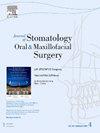使用基于深度学习的物体检测模型自动检测面部骨骼 CT 图像中的面部中间骨折。
IF 1.8
3区 医学
Q2 DENTISTRY, ORAL SURGERY & MEDICINE
Journal of Stomatology Oral and Maxillofacial Surgery
Pub Date : 2024-10-01
DOI:10.1016/j.jormas.2024.101914
引用次数: 0
摘要
背景:面中部骨折是最常见的面部骨折之一。建议在受伤后 2 周内进行手术,但由于在繁忙的急诊医学环境中诊断成像漏掉了骨折,手术时间往往被延长。深度学习技术在各个领域都取得了显著进展,我们试图利用该技术开发一套自动检测面部正中骨折的系统。本研究的目的是利用该系统准确、快速地诊断骨折,以期使患者和急诊室医生都能从中受益:方法:准备了 100 张包括面部中部骨折(如上颌骨、颧骨、鼻骨和眼眶骨折)的计算机断层扫描图像。在每张轴向图像中,骨折区域被一个矩形区域包围,以创建标注数据。80 张图像被随机归类为训练数据集(3736 片),20 张图像被随机归类为验证数据集(883 片)。训练和验证均使用物体检测算法 Single Shot MultiBox Detector(SSD)和 You Only Look Once(YOLOv8)第 8 版进行:SSD和YOLOv8的性能指标分别为:精确度0.872和0.871;召回率0.823和0.775;F1得分0.846和0.82;平均精确度0.899和0.769:深度学习技术的使用使得面中部骨折的自动检测具有良好的准确性和较高的速度。本研究开发的系统有望用于面中部骨折的自动检测,并可为紧急医疗护理和其他场合提供快速、准确的解决方案。本文章由计算机程序翻译,如有差异,请以英文原文为准。
Automatic detection of midfacial fractures in facial bone CT images using deep learning-based object detection models
Background
Midfacial fractures are among the most frequent facial fractures. Surgery is recommended within 2 weeks of injury, but this time frame is often extended because the fracture is missed on diagnostic imaging in the busy emergency medicine setting. Using deep learning technology, which has progressed markedly in various fields, we attempted to develop a system for the automatic detection of midfacial fractures. The purpose of this study was to use this system to diagnose fractures accurately and rapidly, with the intention of benefiting both patients and emergency room physicians.
Methods
One hundred computed tomography images that included midfacial fractures (e.g., maxillary, zygomatic, nasal, and orbital fractures) were prepared. In each axial image, the fracture area was surrounded by a rectangular region to create the annotation data. Eighty images were randomly classified as the training dataset (3736 slices) and 20 as the validation dataset (883 slices). Training and validation were performed using Single Shot MultiBox Detector (SSD) and version 8 of You Only Look Once (YOLOv8), which are object detection algorithms.
Results
The performance indicators for SSD and YOLOv8 were respectively: precision, 0.872 and 0.871; recall, 0.823 and 0.775; F1 score, 0.846 and 0.82; average precision, 0.899 and 0.769.
Conclusions
The use of deep learning techniques allowed the automatic detection of midfacial fractures with good accuracy and high speed. The system developed in this study is promising for automated detection of midfacial fractures and may provide a quick and accurate solution for emergency medical care and other settings.
求助全文
通过发布文献求助,成功后即可免费获取论文全文。
去求助
来源期刊

Journal of Stomatology Oral and Maxillofacial Surgery
Surgery, Dentistry, Oral Surgery and Medicine, Otorhinolaryngology and Facial Plastic Surgery
CiteScore
2.30
自引率
9.10%
发文量
0
审稿时长
23 days
 求助内容:
求助内容: 应助结果提醒方式:
应助结果提醒方式:


